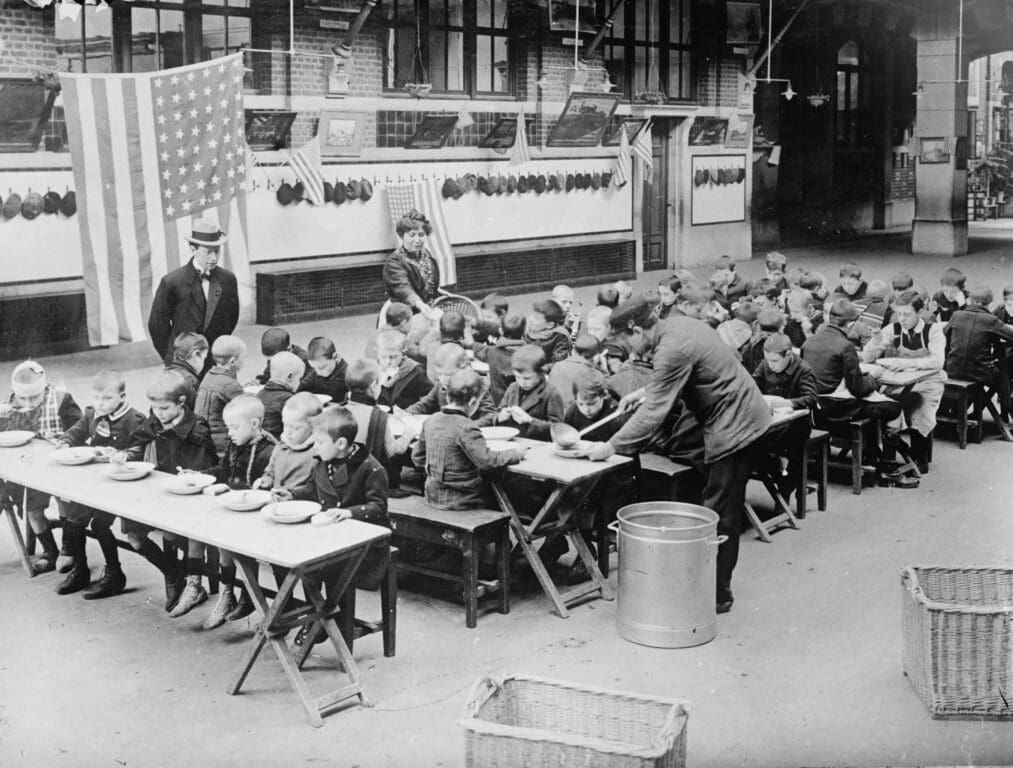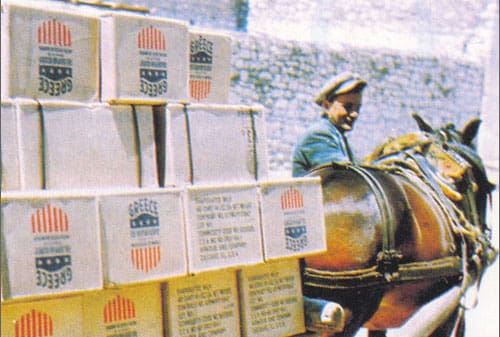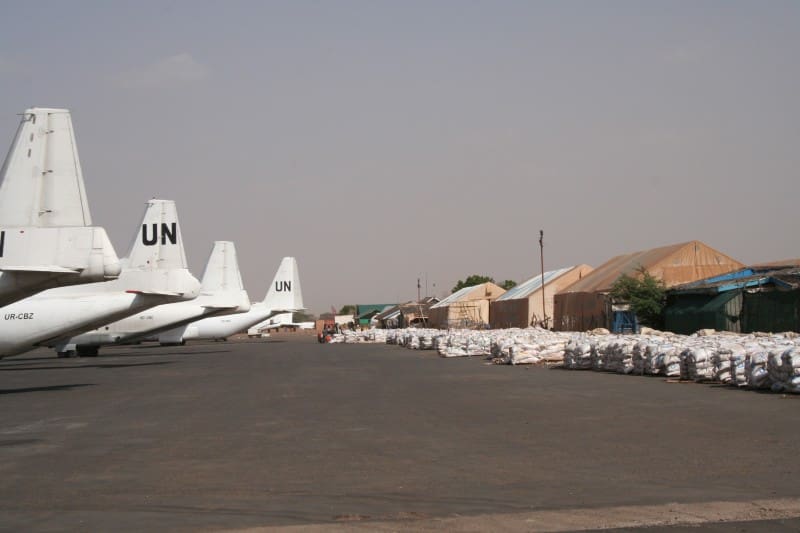World
America’s Legacy and Leadership in Fighting Global Hunger – World Food Program USA

The United States of America has a long history of fighting global hunger and continues to lead those efforts today. The U.S. has long known that humanitarian assistance is economically smart and a vital component of national security.
In the nearly 250 years that the U.S. has been around, food assistance programs have been part of the majority of our history.
America’s First Shipments of Food Assistance
In 1812, a devasting earthquake hit Venezuela. The quake left thousands of people in urgent need of food and supplies. In response, the U.S. sent five ships carrying $50,000 dollars-worth of wheat flour to feed survivors.
America’s second major humanitarian response was in 1845 when the Irish Potato Famine hit. The U.S. government provided two ships and loaded them with food from the U.S. nonprofit Catholic Charities to send to the people of Ireland.
During this early period, the food aid the U.S. sent was small and intended to meet people’s immediate needs.
The United States Scales Global Food Aid After World War I
During World War I, German occupation and British blockades caused mass food shortages in Belgium. The threat of famine began to loom as food remained scarce. Under Herbert Hoover’s leadership, the U.S. established the Commission for Relief in Belgium (CRB) which provided food assistance to 10 million Belgians and French people. The U.S. also provided a $100 million dollars for broader food assistance operations across Europe.

After World War I, Hoover continued hunger relief efforts by organizing shipments of food for the millions facing starvation in postwar Europe. As program director of the newly established American Relief Administration (ARA), he sent aid to prevent famine in Soviet Russia. Within a year, the ARA was feeding nearly 11 million people a day through 19,000 kitchens across the country.
The CRB and ARA were some of the first official institutions created in the U.S. to fight against global hunger. And the need for such programs would prove especially strong in the next world war.
The United States Leads Global Hunger Relief After World War II
In the aftermath of World War II, millions of people around the world were starving.
President Harry Truman was integral in rallying American relief efforts to address Europe’s food security crisis. Following a recommendation from Herbert Hoover, the U.S. began providing food and supplies under the new United Nations Relief and Rehabilitation Administration (UNRRA), an organization created to help survivors recover from the war.
However, it was evident that UNRRA’s relief efforts were not enough to alleviate Europe’s food insecurity. Championed by Undersecretary of State Dean Acheson and Secretary of State George Marshall, President Truman signed the Economic Recovery Act of 1948 to provide economic assistance to 16 European countries. The Act, which became known as the Marshall Plan, provided the equivalent of $100 billion dollars for European reconstruction — much of it being food and agricultural assistance. Most European countries received sufficient food supplies with the support of the Marshall Plan. The Marshall Plan laid the foundation for how aid can assist communities abroad while advancing U.S. national security interests.

In Japan, the war had left the nation on the brink of famine and children suffered the most. As the situation grew worse, General Douglass MacArthur ordered an extensive child nutrition program for Japan, including school meals. In coordination with the Japanese government, the U.S. began implementing the program in 1947 and scaled it to reach 7 million children across Japan.
America’s First Long-Term Hunger-Fighting Program
In the early 1950s, the U.S. had a surplus of food. Technical advances in agriculture had allowed farms in the U.S. to grow more food and at a faster rate. Agricultural productivity was rising in the country, and we had food to spare.
In 1954, the Eisenhower administration saw an opportunity to put these surpluses towards efforts to rebuild food systems and combat hunger abroad after the war. His administration passed a series of policies that included granting U.S. grown commodities as humanitarian aid, known as the Food for Peace Act. This program took food grown in the U.S. and delivered it abroad to people in need.
Today, the Food for Peace program is America’s longest standing permanent program for providing international food aid. Through Food for Peace, the U.S. consistently allocates resources to respond to hunger emergencies around the world every year.
The United States Helps Creates the U.N. World Food Programme
In 1960, President Dwight D. Eisenhower addressed the U.N. General Assembly and spoke on the issue of world hunger:
“We must never forget that there are hundreds of millions of people, particularly in the less developed parts of the world, suffering from hunger and malnutrition, even though a number of countries, my own included, are producing food in surplus. This paradox should not be allowed to continue.”
Eisenhower proposed to the U.N. General Assembly that a “workable scheme should be devised for providing food aid through the U.N. system.” This idea would take root in the following year.
In April 1961, George McGovern, the director of the U.S. Food for Peace Program at the time, proposed establishing a multilateral food aid program with a fund of $100 million in food and cash on a three-year experimental basis.
On November 24, 1961, Eisenhower’s call for a “workable scheme” to provide food aid through the U.N. system came to fruition when the U.N. General Assembly officially established the United Nations World Food Programme (WFP).
Also in 1961, under John F. Kennedy’s administration, the U.S. shifted its approach to humanitarian aid. Food aid programs became less of a means of distributing surplus food, and more of a strategic tool to address hunger.
On November 3, Kennedy created the United States Agency for International Development (USAID) to lead the U.S. government’s international development and humanitarian efforts.
The U.N. World Food Programme’s First Humanitarian Missions
The U.N. World Food Programme’s first mission was in response to an earthquake that hit Iran in 1962 and killed over 12,000 people. The U.N. World Food Programme provided survivors with wheat, sugar and tea. A year later in 1963, it launched its school meals program by delivering food to 5,000 children in Togo.

By 1965, the U.N. World Food Programme proved to be successful and became an official U.N. agency. Over the next few decades, it launched dozens of missions in response to disasters all over the world, including Ethiopia, Honduras, Rwanda, Sudan and Cambodia. Today, the U.N. World Food Programme is one of the world’s largest hunger-fighting organizations with a presence in 120 countries and territories. It reaches over 150 million people every year with lifesaving food assistance.
American Leadership of the U.N. World Food Programme
The U.N. World Food Programme has had many leaders since its inception in 1961. In 1992, Catherine Bertini was the first American to serve as Executive Director of the global organization, and also the first woman to lead a United Nations agency. Since then, the U.N. World Food Programme has been led by an American without interruption, continuing up to Cindy McCain today.
The U.S. has also continued to be the largest government donor to the U.N. World Food Programme through programs like Food for Peace and USAID.
The United States Expands Its School Meals Program for Children Worldwide
The common thread throughout America’s history with international food aid is bipartisanship. Both Republicans and Democrats have rallied behind the mission of sending food to people facing hunger.
During the 1970s, Senators George McGovern and Bob Dole teamed up to reform America’s food stamp program (now known as SNAP), expand the domestic school lunch program and establish the Special Supplemental Food Program for Women, Infants, and Children (WIC).

In the late 1990s, the two worked together again to apply lessons from their national school lunch program to the world’s poorest classrooms – ensuring kids everywhere have access to a nourishing meal. Thanks to their efforts, the aptly named McGovern-Dole International Food for Education and Child Nutrition Program was established in 2002. This was America’s first global initiative dedicated to feeding hungry children. Through McGovern-Dole, humanitarian agencies like the U.N. World Food Programme could now stock school meals programs overseas using U.S. crops and leverage financial and technical assistance from the U.S. government. Since the program’s inception, it’s reached more than 40 million children abroad.
The United States’ New Methods for Food Aid
For most of its history in food assistance, the U.S. relied on the agricultural community. It purchased food from U.S. farms and shipped it abroad. That changed in 2010 with the creation of the Emergency Food Security Program (EFSP).
EFSP is a cash-based program that enables humanitarian aid to be more flexible in emergencies. Organizations like the U.N. World Food Programme can use that cash to purchase food locally in the countries they’re working in or provide cash vouchers so people can buy food from local markets. .
Today, the U.S. provides organizations like the U.N. World Food Programme with a balance of cash and American-grown food so they can respond to emergencies with the right tool in the right place at the right time.

Photo: WFP/Gali NKINZO
America’s Long Legacy and Enduring Leadership in Food Aid
Since its founding, the U.S. has built a legacy of providing humanitarian food assistance. It’s why the history of the United States and the U.N. World Food Programme are deeply intertwined. News anchor Scott Pelley once said that the U.N. World Food Programme is “one of the best ideas America ever had.” He was right.
Learn more about U.S. humanitarian aid and how to advocate Congress to help end hunger:










